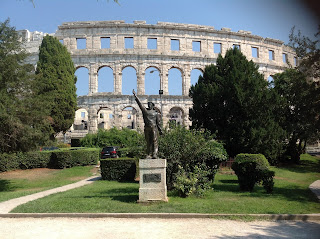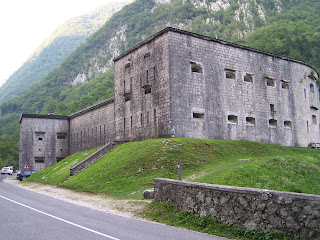I spent yesterday in the Military Frontier that used to cover most of Croatia and northern Bosnia - separating the Hapsburg and Ottoman empires.
For around three hundred years militias on both sides faced each other and conducted a small war in between the formal conflicts. The troops were variously labelled Hajduks, Vojnuks, Martelosi or Grenzer. It was more formalised on the Croatian side where the Grenzer settlers had special privileges and restrictions to provide a defensive buffer. Later they also provided useful regiments for wars away from the border.
My trip started at the Croatian city of Karlovac, formerly Karlstadt. This was the military headquarters of the Croatian part of the military border. It's now a busy industrial city and not much remains of the star shaped fortifications that surrounded the old city. However, there is the older castle of Dubovac to the west of city that is in excellent condition and provides a great view. Sadly, despite arriving within the published opening hours, it was closed.
After a quick stop at the Croatian Homeland War Museum, at what was formerly an outpost for the fortress, we drove through the border area. For the benefit of wargamers the terrain is overwhelmingly forest. There are even still a few scars on the buildings from the Homeland War, twenty years ago.
The next castle is just over the border into Bosnia at Velika Kladusa. The old castle has been extensively renovated and is used as holiday apartments with a function area for weddings. A very helpful young English speaking member of staff took us around. There are a few WW2 era artillery pieces in the grounds, used again in the Homeland War.
Finally, further down the road towards Bihac, there is Ostrozac. This really is a magnificent and very large Bosnian castle. When I last visited in 2006 there was some restoration work going on. Sadly, not much progress appears to have been made, but the essential features of the castle remain.
A word of warning if you fancy a trip here, allow plenty of time. Don't expect too many helpful road signs! Essentially, you have to drive into the towns and think, where would I build a castle here? Then drive around side roads until you come across it. A picture on the iPad is helpful when seeking help from the locals - who I have always found very friendly and helpful. If a bit bewildered as to what you are doing!
For further reading look no further than Gunther Rothenberg's two volume history on the military border. Long out of print I'm afraid, but your local library may be able to get a copy. However, this paper, The Krajina Project: Exploring the Ottoman-Habsburg Borderland, by R J Carlton and A Rushworth, is well worth a read.






















































